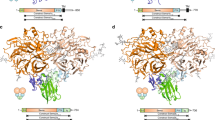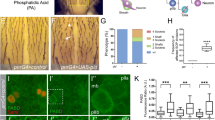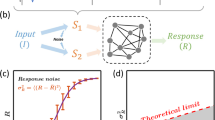Abstract
How are signalling molecules organized into different pathways within the same cell? In Drosophila, the inaD gene encodes a protein consisting of five PDZ domains which serves as a scaffold to assemble different components of the phototransduction cascade, including the principal light-activated ion channels, the effector phospholipase C-β and protein kinase C. Null inaD mutants have a dramatically reorganized subcellular distribution of signalling molecules, and a total loss of transduction complexes. Also, mutants defective in a single PDZ domain produce signalling complexes that lack the target protein and display corresponding defects in their physiology. A picture emerges of a highly organized unit of signalling, a ‘transducisome’, with PDZ domains functioning as key elements in the organization of transduction complexes in vivo.
This is a preview of subscription content, access via your institution
Access options
Subscribe to this journal
Receive 51 print issues and online access
$199.00 per year
only $3.90 per issue
Buy this article
- Purchase on Springer Link
- Instant access to full article PDF
Prices may be subject to local taxes which are calculated during checkout







Similar content being viewed by others
References
Schlessinger, J. SH2/SH3 signaling proteins. Curr. Opin. Genet. Dev. 4, 25–30 (1994).
Pawson, T. SH2 and SH3 domains in signal transduction. Adv. Cancer Res. 64, 87–110 (1994).
Lemmon, M. A., Ferguson, K. M. & Schlessinger, J. PH domains: diverse sequences with a common fold recruit signaling molecules to the cell surface. Cell 85, 621–624 (1996).
Shaw, G. The plackstrin homology domain: an intriguing multifunctional protein module. Bioessays 18, 35–46 (1996).
Harrison, S. C. Peptide-surface association: the case of PDZ and PTB domains. Cell 86, 341–343 (1996).
van der Greer, P. & Pawson, T. The PTB domain: a new protein module implicated in signal transduction. Trends Biochem. Sci. 20, 277–280 (1995).
Kavanaugh, W. M., Turck, C. W. & Williams, L. T. PTB domain binding to signaling proteins through a sequence motif containing phosphotyrosine. Science 268, 1177–1179 (1995).
Woods, D. F. & Bryant, P. J. The discs-large tumor suppressor gene of Drosophila encodes a guanylate kinase homolog localized at septate junctions. Cell 66, 451–464 (1991).
Cho, K. O., Hunt, C. A. & Kennedy, M. B. The rat brain postsynaptic density fraction contains a homolog of the Drosophila discs-large tumor suppressor protein. Neuron 9, 929–942 (1992).
Woods, D. F. & Bryant, P. J. ZO-1, DlgA and PSD-95/SAP90: homologous proteins in tight, septate and synaptic cell junctions. Mech. Dev. 44, 85–89 (1993).
Kennedy, M. B. Origin of PDZ (DHR, GLGF) domains. Trends Biochem. Sci. 20, 350 (1995).
Kornau, H. C., Schenker, L. T., Kennedy, M. B. & Seeburg, P. H. Domain interaction between NMDA receptor subunits and the postsynaptic density protein PSD-95. Science 269, 1737–1740 (1995).
Saras, J. & Heldin, C. H. PDZ domains bind carboxy-terminal sequences of target proteins. Trends Biochem. Sci. 21, 455–458 (1996).
Sheng, M. & Kim, E. Ion channel associated proteins. Curr. Opin. Neurobiol. 6, 602–608 (1996).
Sheng, M. PDZs and receptor/channel clustering: rouding up the latest suspects. Neuron 17, 575–578 (1996).
Muller, B. M. et al. SAP102, a novel postsynaptic protein that interacts with NMDA receptor complexes in vivo. Neuron 17, 255–265 (1996).
Niethammer, M., Kim, E. & Sheng, M. Interaction between the C terminus of NMDA receptor subunits and multiple members of the PSD-95 family of membrane-associated guanylate kinases. J. Neurosci. 16, 2157–2163 (1996).
Kim, E., Cho, K. O., Rothschild, A. & Sheng, M. Heteromultimerization and NMDA receptor-clustering activity of Chapsyn-110, a member of the PSD-95 family of proteins. Neuron 17, 103–113 (1996).
Kim, E., Niethammer, M., Rothschild, A., Jan, Y. N. & Sheng, M. Clustering of Shaker-type K+channels by interaction with a family of membrane-associated guanylate kinases. Nature 378, 85–88 (1995).
Kim, E. & Sheng, M. Differential K+channel clustering activity of PSD-95 and SAP97, two related membrane-associated putative guanylate kinases. Neuropharmacology 35, 993–1000 (1996).
Cohen, N. A., Brenman, J. E., Snyder, S. H. & Bredt, D. S. Binding of the inward rectifier K+channel Kir 2.3 to PSD-95 is regulated by protein kinase A phosphorylation. Neuron 17, 759–767 (1996).
Kim, E. et al. GKAP, a novel synaptic protein that interacts with the guanylate kinase-like domain of the PSD-95/SAP90 family of channel clustering molecules. J. Cell Biol. 136, 669–678 (1997).
Brenman, J. E. et al. Interaction of nitric oxide synthase with the postsynaptic density protein PSD-95 and α-syntrophin mediated by PDZ-domains. Cell 84, 757–767 (1996).
Budnik, V. et al. Regulation of synapse structure and function by the Drosophila tumor suppressor gene dlg. Neuron 17, 627–640 (1996).
Brenman, J. E., Christopherson, K. S., Craven, S. E., McGee, A. W. & Brdt, D. S. Cloning and characterization of postsynaptic density 93, a nitric oxide synthase interacting protein. J. Neurosci. 16, 7407–7415 (1996).
Sato, T., Irie, S., Kitada, S. & Reed, J. C. FAP-1: a protein tyrosine phosphatase that associates with Fas. Science 268, 411–415 (1995).
Doyle, D. A. et al. Crystal structures of a complexed and peptide-free membrane protein-binding domain: molecular basis of peptide recognition by PDZ. Cell 85, 1067–1076 (1996).
Cabral, J. H. et al. Crystal structure of a PDZ domain. Nature 382, 649–652 (1996).
Fanning, A. S. & Anderson, J. M. Protein-protein interactions: PDZ domain networks. Curr. Biol. 6, 1385–1388 (1996).
Ranganathan, R., Malicki, D. M. & Zuker, C. S. Signal transduction in Drosophila photorctprs. Annu. Rev. Neurosci. 18, 283–317 (1995).
Suzuki, E., Katayama, E. & Hirosawa, K. Structure of photoreceptive membranes of Drosophila compound eyes as studies by quick-freezing electron microscopy. J. Electron Microsc. 42, 178–184 (1993).
Pak, W. L. Drosophila in vision research. The Friedenwald Lecture. Invest. Ophthalmol. Vis. Sci. 36, 2340–2357 (1995).
Niemeyer, B. A., Suzuki, E., Scott, K., Jalink, K. & Zuker, C. S. The Drosophila light-activated conductance is composed of the two channels TRP and TRPL. Cell 85, 651–659 (1996).
Smith, D. P. et al. Photoreceptor deactivation and retinal degeneration mediated by a photoreceptor-specific protein kinase C. Science 254, 1478–1484 (1991).
Pak, W. L. Mutants Affecting the Vision in Drosophila melanogaster (Plenum, New York, (1975)).
Shieh, B.-H. & Niemeyer, B. Anovel protein encoded by the InaD gene regulates recovery of visual transduction in Drosophila. Neuron 14, 201–210 (1995).
Shieh, B. H. & Zhu, M. Y. Regulation ofthe TRP Ca2+channel by INAD in Drosophila photoreceptors. Neuron 16, 991–998 (1996).
Huber, A. et al. The transient receptor potential protein (Trp), a putative store-operated Ca2+channel essential for phosphoinositide-mediated photoreception, forms a signaling complex with NorpA, InaC and InaD. EMBO J. 15, 7036–7045 (1996).
Chevesich, J., Kreuz, A. J. & Montell, C. Requirement for the PDZ domain protein, INAD, for localization of the TRP store-operated channel to a signaling complex. Neuron 18, 95–105 (1997).
Songyang, Z. et al. Recognition of unique carboxyl-terminal motifs by distinct PDZ domains. Science 275, 73–77 (1997).
Yeandle, S. thesis, Johns Hopkins Univ.((1957)).
Baylor, D. A., Lamb, T. D. & Yau, K.-W. Responses of retinal rods to single photons. J. Physiol. (Lond.) 288, 613–634 (1979).
Minke, B. Is the receptor potential of fly photoreceptors a summation of single-photon responses? Comments Theor. Biol. 3, 229–263 (1994).
Scott, K., Leslie, A., Sun, Y., Hardy, R. & Zuker, C. Gαq protein function in vivo: Genetic dissection of its role in photoreceptor cell physiology. Neuron 15, 919–927 (1995).
Marcus, S., Polverino, A., Barr, M. & Wigler, M. Complexes between STE5 and components of the pheromone-responsive mitogen-activated protein kinase module. Proc. Natl Acad. Sci. USA 91, 7762–7766 (1994).
Printen, J. A. & Sprague, G. J. Protein–protein interactions in the yeast pheromone response pathway: Ste5p interacts with all members of the MAP kinase cascade. Genetics 138, 609–619 (1994).
Choi, K. Y., Satterberg, B., Lyons, D. M. & Elion, E. A. Ste5 tethers multiple protein kinases in the MAP kinase cascade required for mating in S. cerevisiae. Cell 78, 499–512 (1994).
Larrivee, D. C., Conrad, S. K., Stephenson, R. S. & Pak, W. L. Mutation that selectively affects rhodopsin concentration in the peripheral photoreceptors of Drosophila melanogaster. J. Gen. Physiol. 78, 521–545 (1981).
Johnson, E. & Pak, W. Electrophysiological study of Drosophila rhodopsin mutants. J. Gen. Physiol. 88, 651–673 (1986).
Hualing, D. et al. GRIP: a synaptic PDZ domain-containing protein that interacts with AMPA receptors. Nature 386, 279–284 (1997).
Acknowledgements
We thank B. Niemeyer for advice, initial observations and discussions; D. Schultz for help with the yeast two-hybrid system; E. Koundakjian and D. Cowan for help with the F3 screen; and R.MacKinnon and members of the Zuker laboratory for discussions. S.T. is a fellow of the American Cancer Society; J. S. is supported by the Pew Latin American Scholars Program; R.B. was supported by a Markey predoctoral training grant; and C.S.Z. is an investigator of the Howard Hughes Medical Institute.
Author information
Authors and Affiliations
Corresponding author
Rights and permissions
About this article
Cite this article
Tsunoda, S., Sierralta, J., Sun, Y. et al. A multivalent PDZ-domain protein assembles signalling complexes in a G-protein-coupled cascade. Nature 388, 243–249 (1997). https://doi.org/10.1038/40805
Received:
Accepted:
Issue Date:
DOI: https://doi.org/10.1038/40805
This article is cited by
-
Scribble co-operatively binds multiple α1D-adrenergic receptor C-terminal PDZ ligands
Scientific Reports (2019)
-
Structure function relations in PDZ-domain-containing proteins: Implications for protein networks in cellular signalling
Journal of Biosciences (2018)
-
ScaPD: a database for human scaffold proteins
BMC Bioinformatics (2017)
-
PKCα diffusion and translocation are independent of an intact cytoskeleton
Scientific Reports (2017)
-
Individual protomers of a G protein-coupled receptor dimer integrate distinct functional modules
Cell Discovery (2015)
Comments
By submitting a comment you agree to abide by our Terms and Community Guidelines. If you find something abusive or that does not comply with our terms or guidelines please flag it as inappropriate.



